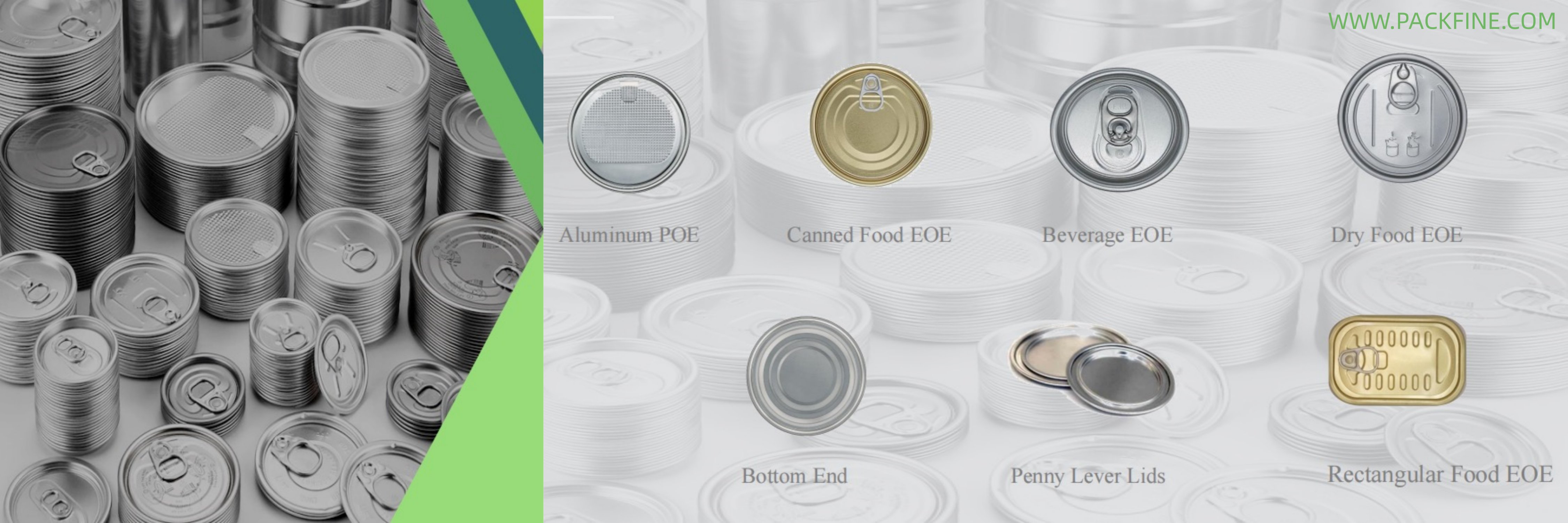अॅल्युमिनियम कॅनचे झाकण विरुद्ध टिनप्लेट कॅनचे झाकण: कोणते चांगले आहे?
कॅनिंग ही पेये आणि इतर उत्पादनांचे प्रकार जतन करण्याचा एक सामान्य मार्ग आहे. कोणत्याही उत्पादनाचे शेल्फ लाइफ वाढवण्याचा हा एक उत्तम मार्ग नाही तर ते ताजे राहतील आणि त्यांची मूळ चव टिकवून ठेवतील याची खात्री करण्याचा हा एक उत्तम मार्ग आहे.
या ब्लॉगमध्ये, आम्ही कॅनच्या झाकणांसाठी वापरल्या जाणाऱ्या दोन सर्वात लोकप्रिय साहित्यांची तुलना करू आणि त्यांची तुलना करू: अॅल्युमिनियम आणि टिनप्लेट.
अॅल्युमिनियम कॅनचे झाकण त्यांच्या सोयीसाठी आणि बहुमुखी प्रतिभेसाठी ओळखले जातात. ते कॅनच्या वर लावलेल्या अॅल्युमिनियमच्या पातळ थराचा वापर करून तयार केले जातात, ज्यामुळे ते उघडणे सोपे होते आणि पुन्हा वापरता येतात.
अॅल्युमिनियम कॅन झाकणांचा एक प्रमुख फायदा म्हणजे त्यांचा टिकाऊपणा. त्यांच्या ताकदीमुळे ते तापमानातील तीव्र बदलांना तोंड देऊ शकतात, ज्यामुळे ते रेफ्रिजरेटेड आणि नॉन-रेफ्रिजरेटेड उत्पादनांमध्ये वापरण्यासाठी आदर्श बनतात. शिवाय, ते वजनाने हलके आहेत, ज्यामुळे किंमत कमी होते.
अॅल्युमिनियम कॅन झाकणांचा आणखी एक महत्त्वाचा फायदा म्हणजे त्यांचा पर्यावरणपूरकपणा. पुनर्वापर केल्यावर, अॅल्युमिनियम हे अशा काही पदार्थांपैकी एक आहे जे त्याची गुणवत्ता न गमावता पुन्हा वापरले जाऊ शकते. यामुळे अॅल्युमिनियम कॅन झाकण अधिक टिकाऊ पर्याय बनतात, कारण ते १००% पुनर्वापर करण्यायोग्य आहेत.
तथापि, महागड्या उत्पादन प्रक्रियेमुळे कॅनचे झाकण टिनप्लेट कॅनच्या झाकणांपेक्षा महाग असतात. शिवाय, उच्च आम्लता असलेल्या क्षारतेची आवश्यकता असलेल्या उत्पादनांसाठी ते योग्य नाहीत, कारण ते अॅल्युमिनियमशी प्रतिक्रिया देऊ शकतात आणि उत्पादनाच्या चव आणि गुणवत्तेवर परिणाम करू शकतात.
टिनप्लेट कॅनचे झाकण हे टिनच्या थराने लेपित केलेल्या स्टीलच्या पातळ शीटपासून बनवले जातात. ते सामान्यतः गंज आणि गंज सहन करण्याच्या क्षमतेसाठी ओळखले जातात, ज्यामुळे ते उच्च आम्लता किंवा क्षारता पातळी असलेल्या उत्पादनांमध्ये वापरले जातात.
टिनप्लेट कॅन झाकणांचा एक प्राथमिक फायदा म्हणजे त्यांची किफायतशीरता. अॅल्युमिनियमच्या तुलनेत टिनप्लेटची प्रक्रिया तुलनेने स्वस्त आहे, ज्यामुळे ते अधिक किफायतशीर पर्याय बनतात.
टिनप्लेट कॅनचे झाकण ब्रँडिंग आणि लेबलिंगसाठी अधिक उपयुक्त आहेत कारण त्यांची पृष्ठभाग अॅल्युमिनियमच्या तुलनेत गुळगुळीत असते. शिवाय, ते कमी प्रतिक्रियाशील असल्याने उच्च आम्लता किंवा अल्कधर्मी आवश्यक असलेल्या उत्पादनांसाठी अधिक योग्य आहेत.
तथापि, टिनप्लेट कॅनचे झाकण अॅल्युमिनियम कॅनच्या झाकणांइतके टिकाऊ नसतात. स्टील तुलनेने जड असते आणि त्यामुळे वाहतूक खर्च जास्त येतो. याव्यतिरिक्त, टिनप्लेट कॅनचे झाकण पर्यावरणपूरक नसतात कारण पुनर्वापराचा खर्च जास्त असल्याने केवळ 30% स्टील कॅनचे पुनर्वापर केले जाते.
तर, कोणते चांगले आहे?
या प्रश्नाचे उत्तर शेवटी कॅन केलेल्या उत्पादनाच्या विशिष्ट गरजांवर अवलंबून असते. जर कॅन केलेले वजन कमी, टिकाऊ आणि पर्यावरणपूरक कॅन झाकण आवश्यक असेल, तर अॅल्युमिनियम कॅन झाकण हा एक चांगला पर्याय आहे. जर ब्रँडिंग आणि लेबलिंग आवश्यक असेल, तसेच किफायतशीरता असेल, तर टिनप्लेट कॅन अधिक योग्य पर्याय आहे. शिवाय, जर उत्पादनात उच्च आम्लता किंवा क्षारता असेल, तर टिनप्लेट कॅन झाकण उत्पादनाच्या गुणवत्तेवर किंवा चवीवर परिणाम न करता अशा परिस्थितींना तोंड देण्याच्या क्षमतेमुळे अधिक योग्य आहेत.
शेवटी, अॅल्युमिनियम कॅन झाकण आणि टिनप्लेट कॅन झाकण दोन्हीचे स्वतःचे वेगळे फायदे आणि तोटे आहेत. दोघांमधील निवड पूर्णपणे कॅन केलेल्या उत्पादनाच्या गरजांवर अवलंबून असते, जसे की आम्लता किंवा क्षारतेची पातळी, बजेट, टिकाऊपणा आणि पर्यावरणपूरकता, इतर घटकांसह. शेवटी, उत्पादकाने त्यांच्या उत्पादनासाठी कोणता पर्याय सर्वोत्तम मूल्य प्रदान करतो हे निर्धारित करण्यासाठी अॅल्युमिनियम आणि टिन कॅन झाकणांचे फायदे आणि तोटे तपासून पाहिले पाहिजेत.
स्पर्धात्मक कोटेशन मिळविण्यासाठी आमच्याशी संपर्क साधा!
- Email: director@aluminum-can.com
- व्हॉट्सअॅप: +८६१३०५४५०१३४५
पोस्ट वेळ: मे-१६-२०२३








